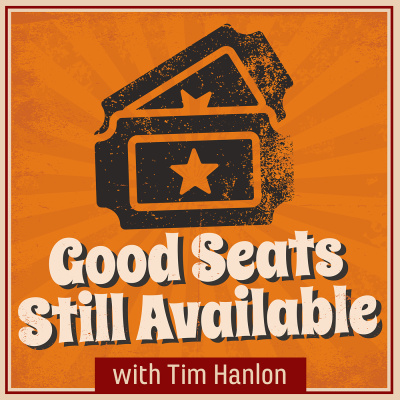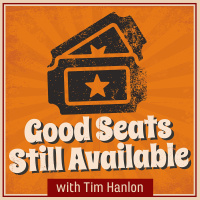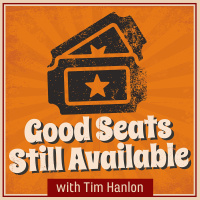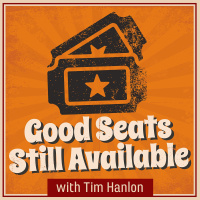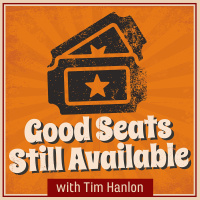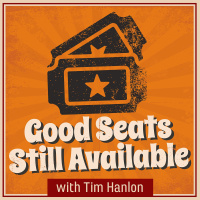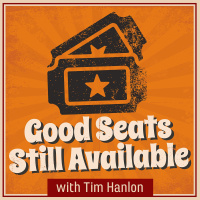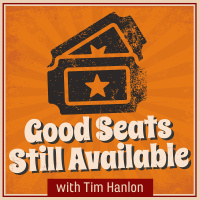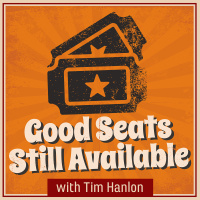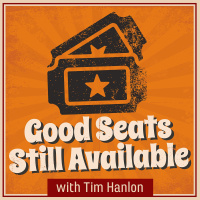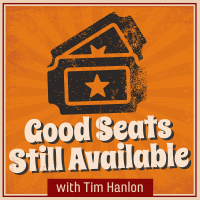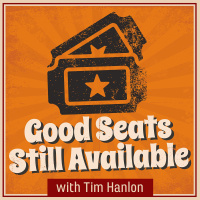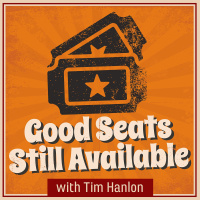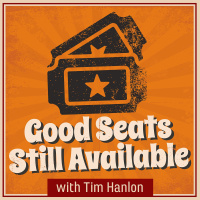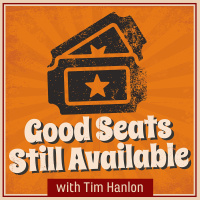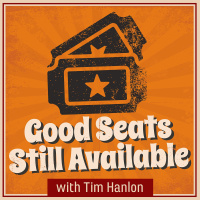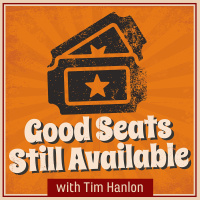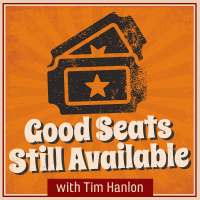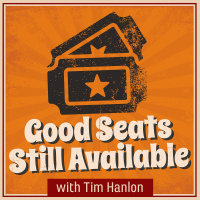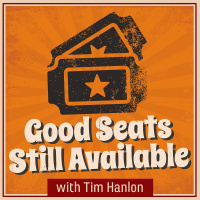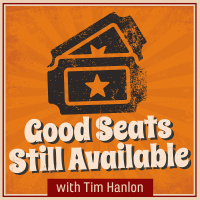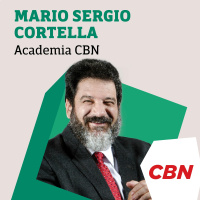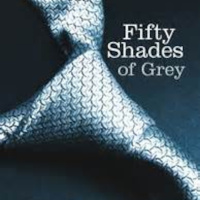Synopsis
Good Seats Still Available is a curious little podcast devoted to the exploration of what used-to-be in professional sports. Each week, host Tim Hanlon interviews former players, owners, broadcasters, beat reporters, and surprisingly famous "super fans" of teams and leagues that have come and gone - in an attempt tounearth some of the most wild and woolly moments in (often forgotten) sports history.
Episodes
-
168: Cumberland Posey’s Negro League Homestead Grays – With Jim Overmyer
15/06/2020 Duration: 01h21minNegro League ace historian/author Jim Overmyer (Queen of the Negro Leagues: Effa Manley and the Newark Eagles; Black Ball and the Boardwalk: The Bacharach Giants of Atlantic City) returns for a deep dive into the extraordinary dual-sport career of Negro League baseball AND Black Fives-era basketball legend Cumberland Posey – including the two dominating teams he founded, owned, managed, and played for – baseball’s Homestead Grays and basketball’s Loendi Big Five. Considered the best African-American hoops player of his time (although not inducted into the Naismith Basketball Hall of Fame until 2016), Posey was a standout collegiate player at Pitt, Penn State and Duquense before launching his semi-pro Loendi club in 1915 – which he built and led to four consecutive Colored Basketball World's Championships from 1919-1923. Posey was already moonlighting as a player with Negro League baseball’s Grays starting in 1911, becoming the team’s manager in 1916, and finally its owner by the early 1920s – ultimately buil
-
167: The “Down Goes Brown” History of the NHL – With Sean McIndoe
08/06/2020 Duration: 01h27minWhile we ruminate on what a potential resumption of the National Hockey League’s delayed 2020 regular season (and playoffs) might look like in the months ahead, we pause to look back at the rich, but altogether confounding history of the world’s premier pro hockey circuit with Down Goes Brown blog scribe and Athletic columnist Sean McIndoe (The Down Goes Brown History of the NHL: The World's Most Beautiful Sport, the World's Most Ridiculous League). Over its often-illogical 103-year history, the NHL has proven to be – as the dust jacket to McIndoe’s loving, but irreverent book intimates – a league that often can't seem to get out of its own way: “No matter how long you've been a hockey fan, you know that sinking feeling that maybe – just maybe – some of the people in charge here don't actually know what they're doing. And at some point, you've probably wondered – has it always been this way? The short answer is yes. As for the longer answer, well, that's this book.” McIndoe helps us cheat-sheet through some
-
166: MISL Soccer’s Los Angeles Lazers – With Ronnie Weinstein
01/06/2020 Duration: 01h26minThe Major Indoor Soccer League’s rocket red ball bounces back our way this week for an Eighties-style rewind into the story of the Los Angeles Lazers – as seen through the eyes of one of its chief front office architects, Ronnie Weinstein. Claimed from dormancy (as the previous Philadelphia Fever) by LA sports baron Dr. Jerry Buss – owner of the 1980 NBA champion Lakers, NHL Kings, 1981 TeamTennis champion Strings, and the building that housed them, Inglewood’s “Fabulous” Forum – the Lazers began life in the MISL in the fall of 1982 under the direction of Weinstein and Buss’ eldest son Johnny. True to its name (and emblematic of the league’s over-the-top promotional zeitgeist), the team immediately became known for its cutting-edge pre-game laser light shows, which management felt ideally suited to the lightning-fast pace of indoor soccer – and hoped would help the Lazers stand out from the wealth of entertainment options available in Southern California. Weinstein, Buss & Co. also tapped heavily into the
-
165: Pioneers of AAGPBL Baseball – With Kat Williams
25/05/2020 Duration: 01h26minIt’s our deepest dive yet into the legendarily one-of-a-kind All-American Girls Professional Baseball League with Marshall University Professor of Women’s Sport History Kat Williams (The All-American Girls After the AAGPBL: How Playing Pro Ball Shaped Their Lives). Widely acknowledged as the forerunner of women's professional league sports in the United States, the pioneering AAGPBL featured more than 600 female players over the course of its twelve seasons between 1943-54 – spanning 15 mid-sized markets across the American Midwest, and drawing sizable crowds – including nearly a million fans at its peak in 1948. In its first season, the league played a game that resembled more softball than baseball: the ball was regulation softball size (12 inches) and the pitcher's mound was only 40 feet from home plate – a third closer than that of men’s baseball. Pitchers threw underhand windmill (as in softball) and the distance between bases was 65 feet – a full 25 feet shorter than in the men’s game. But, over the
-
164: Negro League Baseball’s Atlantic City Bacharach Giants – With Jim Overmyer
18/05/2020 Duration: 01h30minThe curious story of baseball’s Atlantic City (NJ) Bacharach Giants originates from a unique intersection of racism, tourism, and politics. In 1915, an independent semi-pro “Atlantic City Colored League” was formed to provide an entertainment outlet for the city’s 11,000+ black residents – with the hope being they would attend the games and stay off the boardwalk, a then-booming summer haven for white tourists. Two black businessmen active in the local Republican political machine asked an existing area team to join the league and promotionally rename itself after politician Harry Bacharach, the once-and-future mayor of Atlantic City. When the team refused, the duo travelled south and convinced eight members of the Duval Giants, a black amateur team in Jacksonville, Florida, to venture north and create the foundation for a new independent club instead. The “Bacharach Giants” largely dominated whatever opponents came their way during the late 1910s, despite persistent financial wobbliness. In 1920, the
-
163: Once Again, The XFL is Done (Or Is It?) – With ESPN’s Kevin Seifert
11/05/2020 Duration: 01h10minESPN.com NFL Nation reporter Kevin Seifert stops by to help us perform a preliminary autopsy on the surprisingly sudden death of the XFL – WWE founder Vince McMahon’s second attempt at creating a viable alternative professional football league to that of the mighty NFL. A confident, but visibly mellower McMahon announced the league’s unlikely rebirth at a video press conference on January 28, 2018 (two months before a similar launch by the rival Alliance of American Football) – with resolute commitments to professionalism, innovation and fan-friendliness noticeably absent in the XFL’s farcical first incarnation 17 years earlier. Even after the abrupt collapse of the AAF midway through its first season last April, hopes were still high for “XFL 2.0” as its season kicked off in Washington, DC on February 8, 2020 in front of a near-sellout crowd of hometown Defenders fans at the previously “soccer-specific” Audi Field. Like the Alliance, the quality of football was high, initial TV ratings were strong, and enthu
-
162: Les Expos de Montréal – Avec Danny Gallagher
04/05/2020 Duration: 01h22minWe journey north of the border this week to get our first at-bats with the 35-year adventure formerly known as the Montreal Expos, with author and de facto team historian Danny Gallagher (Always Remembered: New Revelations and Old Tales About Those Fabulous Expos). Created in expansionary haste by the National League in 1969, MLB’s first-ever Canadian franchise was named after the city’s futuristic “Expo 67” World’s Fair, and expected to be domiciled in a new domed stadium by 1972 after a temporary stint at a barely-minor-league field in the city’s Jarry Park. Chronically delayed and reshaped by preparations for the 1976 Summer Olympics, that permanent home (a cavernous, drafty and still-unfinished Olympic Stadium) didn’t formally arrive until 1977 – with its promised roof not in place until a full decade later. The Expos’ locational challenges were only slightly overshadowed by their mediocre play on the field – which, while competitive at times (they had the best cumulative winning percentage in the NL
-
161.5: Basketball’s Marvin “Bad News” Barnes – With Mike Carey (Archive Re-Release)
30/04/2020 Duration: 01h59minWe mourn the unexpected passing of longtime Boston-area sportswriter & Marvin "Bad News" Barnes biographer Mike Carey ("Bad News": The Turbulent Life of Marvin Barnes, Pro Basketball's Original Renegade) - with our previous Episode 137 interview from November 3, 2019.
-
161: Jim Bouton: Baseball Original – With Mitch Nathanson
27/04/2020 Duration: 01h50minFrom the day he first stepped into the New York Yankee clubhouse in 1962 at the age of 23, Jim Bouton was baseball’s deceptive revolutionary. Behind the all-American boy-next-door good looks and formidable fastball, lurked an unlikely maverick with a decidedly signature style – both on and off the diamond. Whether it was his frank talk about MLB front office management and player salaries, passionate advocacy of progressive politics, or efforts to convince the Johnson Administration to boycott the 1968 Summer Olympics, “Bulldog” Bouton fearlessly – and seemingly effortlessly – confronted a largely conservative sports world and compelled it to catch up with a rapidly changing American society. On the field, Bouton defied tremendous odds to reach the majors – first with the champion Bronx Bombers (making 1963’s AL All-Star team in his second season, and winning two World Series games in 1964) – and later, with an improbable post-retirement comeback at age 39 with the Atlanta Braves. But in between, it was his
-
160: “Soccertown USA” – With Tom McCabe & Kirk Rudell
20/04/2020 Duration: 01h22minFilm producers Tom McCabe and Kirk Rudell (“Soccertown USA”) join the podcast this week to discuss their newly released documentary about the modest working-class New Jersey town with an outsized influence on the history of the sport of soccer in the United States. In the mid-1980s, as the domestic pro game began to fade with the demise of the once-hot North American Soccer League, and FIFA’s passing over of the US as potential replacement host for the 1986 World Cup – it was three kids from largely-unheralded Kearny, NJ who helped save it. Native sons Tab Ramos, John Harkes, and Tony Meola – who formed the backbone of a Men’s National Team that willed its way to breakthrough success in both the 1990 and 1994 World Cups, and laid the groundwork for the pro game’s rebirth in 1996 with the launch of Major League Soccer – were products of a uniquely rich soccer-passionate culture dating back to the town’s Scottish immigrant influx in the 1870s. Kearny’s storied heritage as a fertile American soccer hotbed – spir
-
159: Chronicling Pro Sports’ “Major” Leagues – With Tom Brucato
13/04/2020 Duration: 01h17minIndustrial writer and fellow defunct sports enthusiast Tom Brucato (Major Sports Leagues) joins this week’s installment of the podcast to delve deep into his all-new update of what can only be described as the Encyclopedia Britannica of forgotten pro sports teams and leagues. The ultimate reference work for the discriminating sports historian, the Second Edition of Major Sports Leagues features the most comprehensive listing of (over 1600) “major league” teams to have ever played across 100+ top-tier US/North American professional leagues in 22 distinct sports: baseball, basketball, bowling, cricket, cycling, football (outdoor & Arena), golf, hockey (ice & roller), lacrosse (outdoor & box), martial arts, polo, rodeo, rugby, soccer (outdoor & indoor), softball, tennis, ultimate disc & volleyball. Brucato walks us through some of the highs and lows of his 20+ year (and counting) odyssey of chronicling the seemingly impossible, including: The self-imposed criteria set out for the project – a
-
158: “Stealing” Dodger Stadium – With Eric Nusbaum
06/04/2020 Duration: 01h14minLA’s Dodger Stadium – opened in April 1962, and now the third-oldest home ballpark in Major League Baseball – is an American icon. But the story of how it came to be goes far beyond baseball. The hills that cradle the stadium were once home to three vibrant semi-rural Mexican American communities – Palo Verde, La Loma and Bishop – collectively known as Chavez Ravine. In the early 1950s, all was condemned via eminent domain to make way for a utopian public housing project called Elysian Park Heights. Then, in a remarkable political turn, the entire idea of public housing in Los Angeles was defeated amidst a Red Scare conspiracy. Instead of getting their homes back, the area’s remaining residents saw the city sell the land to Brooklyn Dodgers owner Walter O’Malley – in an opportunistic effort to finally lure big league baseball to the City of Angels – and definitively confirm its status as a “major league” American metropolis. But before the Dodgers’ new home could be built, municipal officials would have t
-
157: The NASL’s Chicago Sting – With Willy Roy (Part Two)
30/03/2020 Duration: 01h14minWhen 32-year-old Willy Roy and two of his NASL St. Louis Stars teammates were acquired by the still-yet-to-play expansion Chicago Sting in February 1975, the club had just four signed players and a hit movie-inspired logo to its name. No one knew what to expect, and Chicago’s twin pro soccer flame-outs less than a decade earlier – the White Sox-owned USA/NASL Mustangs (1967-68) and the Roy-led 1967 NPSL Spurs – didn’t exactly inspire confidence the Sting would be any different. Indeed, the passion project of prominent Chicago commodities trader and youth soccer parent/convert Lee Stern floundered early and often during its first few seasons under first-time coach (but Manchester United playing legend) Bill Foulkes. Despite a division title in 1976 – the first with the retired Roy as Assistant Coach – the Sting was largely uncompetitive during its first few seasons. Crowds were abysmal, as the team shuffled games between Soldier Field, Comiskey Park, and Wrigley Field each summer. By early-season 1978, the
-
156: National Soccer Hall of Famer Willy Roy
23/03/2020 Duration: 01h06minThough he was born in Germany and still retains the distinctive vocal stylings to prove it, National Soccer Hall of Fame player/coach great Willy Roy has always been a Chicago kid in both heart and heritage. A post-WWII transplant to the Windy City at the age of six, Roy became a standout youth and young adult player in his adopted hometown – and by the mid-1960s, was honing his scoring skills and drawing national attention in the hard-nosed, Chicago-based National Soccer League with the multi-title winning club Hansa. A few call-ups to a rag-tag US National Team soon followed (eventually notching nine goals in 20 caps over nine years and two World Cup qualifying cycles) – and, ultimately, an invitation to play with the Soldier Field-domiciled Chicago Spurs of the new 1967 National Professional Soccer League. One of only eight US citizens across ten franchises, Roy became the NPSL’s second-leading scorer (17G, 5A), made the league All-Star team and won Rookie of the Year honors. When the NPSL merged with
-
155: The Continental Basketball Association’s Albany Patroons – With Brendan Casey
16/03/2020 Duration: 01h22minWith the entirety of pro sports in unprecedented lock-down mode, we offer some respite with a rewind back to the curiously borderline major league Continental Basketball Association (1946-2009), and one of its most successful franchises – the original Albany Patroons (1982-92). Video production firm owner/sports doc filmmaker/Cap City native Brendan Casey (“The Minor League Mecca”) helps us trace the story arc of a team that spent ten memorable seasons punching above its weight both on and off the hardwood. On the court, the Patroons won two CBA titles (1984, 1988), five Eastern Division crowns and complied a league-smashing 50-6 regular season record (28-0 in home games) in its penultimate season – becoming a launching pad for eventual NBA coaching standouts like Phil Jackson, George Karl and Bill Musselman. And a weigh station for notable big-league players past and future such as: Scott Brooks, Tod Murphy, Tony Campbell, Sidney Lowe, Mario Elie, Vincent Askew, and Michael Ray Richardson. In the stands, th
-
154: The National Women’s Football League’s Houston Herricanes – With Olivia Kuan
09/03/2020 Duration: 01h18minHollywood cinematographer and documentary filmmaker Olivia Kuan (Brick House) joins to discuss the revealing story of the Houston "Herricanes" of the pioneering National Women’s Football League (1974-88) – and their overlooked role in the historically rich and surprisingly resilient world of women’s pro football. The modern women’s pro game started innocently enough in 1967, when Cleveland talent agent Sid Friedman launched a barnstorming “Women’s Professional Football League” in which a team (later nine) of women toured the country playing men’s clubs in exhibitions and charity events – sometimes even as NFL and CFL game halftime entertainment. Led by the breakaway Toledo Troopers, the decidedly (and competitively) legit NWFL began play in 1974 with six teams; by 1976, the league had ballooned to 14 franchises from coast-to-coast, including three in football-mad Texas – led by the “Herricanes” of Houston. Though devoid of sustainable budgets, major media coverage or appreciable crowds, the Herricanes (and th
-
153: The All-American Girls Professional Baseball League – With Anika Orrock
02/03/2020 Duration: 01h15minAward-winning illustrator, cartoonist and unwitting baseball historian Anika Orrock (The Incredible Women of the All-American Girls Professional Baseball League) joins to discuss her delightfully visual take on the pioneering circuit that not only helped save America’s pastime – but also became the forerunner of women's professional league sports in the United States. With the US deep into WWII, attendance at Major League Baseball games by 1943 was dwindling and minor leagues were suspending operations as the nation’s war effort siphoned able-bodied men from pro baseball diamonds across the country. To keep interest in the sport alive, Chicago Cubs owner Philip Wrigley spearheaded the formation of an all-female league that featured a spirited blend of competitive moxie and girl-next-door femininity that delighted hundreds of thousands of fans throughout the Midwest and garnered significant national publicity. The quality of play was surprisingly competitive, aided by ex-big league managers like Jimmy Foxx an
-
152: The Senior Professional Baseball Association – With Peter Golenbock
24/02/2020 Duration: 01h18minSpring training is finally under way, and we celebrate the National Pastime with a return visit to the 1989-90 curiosity known as the Senior Professional Baseball Association – with one of its few dedicated chroniclers, prolific sports author Peter Golenbock (The Forever Boys). The brainchild of real estate developer (and former college player) Jim Morley, the SPBA was envisioned as a kind of Senior PGA golf-type circuit for ex-Major League Baseball players aged 35 and older (32+ for catchers), played at Spring training facilities throughout Florida during the traditional baseball off-season. Featuring former All-Star player/labor pioneer Curt Flood as commissioner – and a talent roster that included future Hall of Fame players and managers, Major League batting champions, and Cy Young-winning pitching aces – the “Senior League” drew in big names and sizable media attention, but minuscule crowds. The eight inaugural teams — the Bradenton Explorers, Fort Myers Sun Sox, Gold Coast Suns, Orlando Juice, St. Luci
-
151: “God Save the (Wichita) Wings” – With Adam Knapp & Mike Romalis
17/02/2020 Duration: 01h10minWe gear up for this week’s world premiere of God Save the Wings – the long-awaited documentary about one of the original Major Indoor Soccer League’s most improbable success stories – with co-producers Adam Knapp (Out Here in Kansas) and Mike Romalis (Make This Town Big: The Story of Roy Turner and the Wichita Wings). The Wichita Wings were the smallest-market franchise of not only the fledgling MISL, but also of any major US pro sports circuit when they joined the league in its second season (1979-80) – becoming the first-ever major league professional sports team in Kansas history, and, ultimately, the MISL’s most durable. The Wings defied conventional logic, as world-class soccer players from places like England, Denmark, Argentina, and Ecuador treated sold-out Kansas Coliseum crowds with spirited play that made them a perennial playoff contender and one of the league’s most successful franchises. Although they never captured a championship in their 13 MISL seasons (nor during nine subsequent seasons in th
-
150: Major League Baseball Expansion – With Fran Zimniuch
10/02/2020 Duration: 01h15minBaseball writer Fran Zimniuch (Baseball's New Frontier: A History of Expansion, 1961-1998) help us sketch out a nearly forty-year survey of the major leagues’ fitful journey from a regional set of 16 teams confined to just ten US Northeast and Midwest cities, to the 30-club colossus that today stretches across 27 markets across North America. While the sport’s modern-day wanderlust began in earnest during the 1950s as the Braves moved to Milwaukee, the Browns left for Baltimore (new name: Orioles), the A’s traded Philadelphia for Kansas City, and New York’s Giants and Brooklyn’s Dodgers made haste for California – Major League Baseball entered the 1960s with an urgent need to expand into new markets as the rival Continental League threatened to beat them to the punch. In 1961, the American League added its own Los Angeles franchise with the Angels, and a new expansion version of the Washington Senators hastily replaced their original predecessors, having absconded to the Twin Cities. Two more teams joined th
